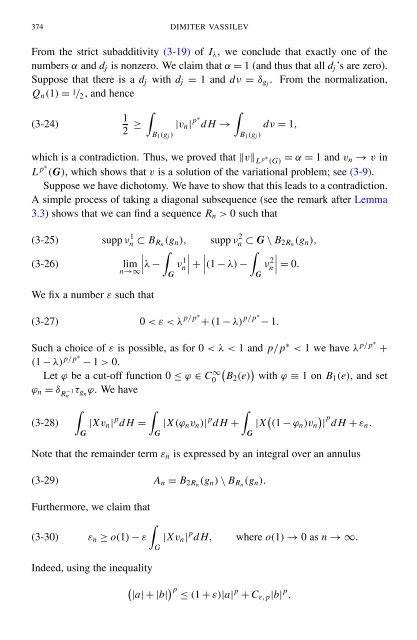Regularity near the characteristic boundary for sub-laplacian operators
Regularity near the characteristic boundary for sub-laplacian operators
Regularity near the characteristic boundary for sub-laplacian operators
You also want an ePaper? Increase the reach of your titles
YUMPU automatically turns print PDFs into web optimized ePapers that Google loves.
374 DIMITER VASSILEV<br />
From <strong>the</strong> strict <strong>sub</strong>additivity (3-19) of I λ , we conclude that exactly one of <strong>the</strong><br />
numbers α and d j is nonzero. We claim that α = 1 (and thus that all d j ’s are zero).<br />
Suppose that <strong>the</strong>re is a d j with d j = 1 and dν = δ gj . From <strong>the</strong> normalization,<br />
Q n (1) = 1 / 2 , and hence<br />
(3-24)<br />
∫<br />
1<br />
2<br />
∫B ≥ |v n | p∗ d H → dν = 1,<br />
1 (g j )<br />
B 1 (g j )<br />
which is a contradiction. Thus, we proved that ‖v‖ L p ∗ (G) = α = 1 and v n → v in<br />
L p∗ (G), which shows that v is a solution of <strong>the</strong> variational problem; see (3-9).<br />
Suppose we have dichotomy. We have to show that this leads to a contradiction.<br />
A simple process of taking a diagonal <strong>sub</strong>sequence (see <strong>the</strong> remark after Lemma<br />
3.3) shows that we can find a sequence R n > 0 such that<br />
(3-25)<br />
(3-26)<br />
supp νn 1 ⊂ B R n<br />
(g n ), supp νn 2 ⊂ G \ B 2R n<br />
(g n ),<br />
∫<br />
∫<br />
∣<br />
∣<br />
lim ∣λ − ∣ + ∣(1 − λ) − ∣ = 0.<br />
n→∞<br />
νn<br />
1<br />
G<br />
νn<br />
2<br />
G<br />
We fix a number ε such that<br />
(3-27) 0 < ε < λ p/p∗ + (1 − λ) p/p∗ − 1.<br />
Such a choice of ε is possible, as <strong>for</strong> 0 < λ < 1 and p/p ∗ < 1 we have λ p/p∗ +<br />
(1 − λ) p/p∗ − 1 > 0.<br />
Let ϕ be a cut-off function 0 ≤ ϕ ∈ C0<br />
∞ (<br />
B2 (e) ) with ϕ ≡ 1 on B 1 (e), and set<br />
ϕ n = δ R<br />
−1 τ g n n<br />
ϕ. We have<br />
∫<br />
∫<br />
∫<br />
(3-28) |Xv n | p d H = |X (ϕ n v n )| p d H + |X ( ) p<br />
(1 − ϕ n )v n | d H + εn .<br />
G<br />
G<br />
G<br />
Note that <strong>the</strong> remainder term ε n is expressed by an integral over an annulus<br />
(3-29) A n = B 2Rn (g n ) \ B Rn (g n ).<br />
Fur<strong>the</strong>rmore, we claim that<br />
∫<br />
(3-30) ε n ≥ o(1) − ε |Xv n | p d H, where o(1) → 0 as n → ∞.<br />
G<br />
Indeed, using <strong>the</strong> inequality<br />
(<br />
|a| + |b|<br />
) p ≤ (1 + ε)|a| p + C ε,p |b| p ,
















